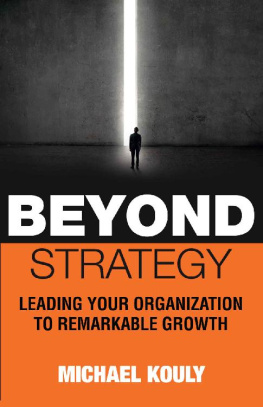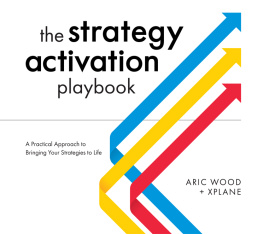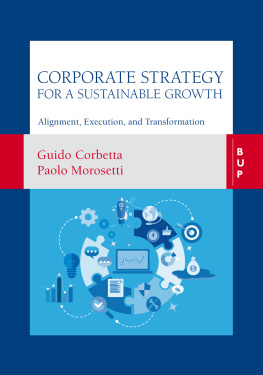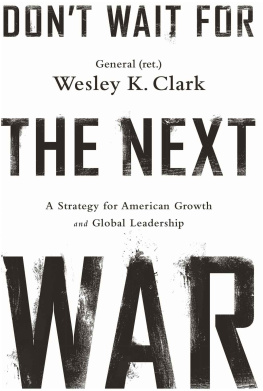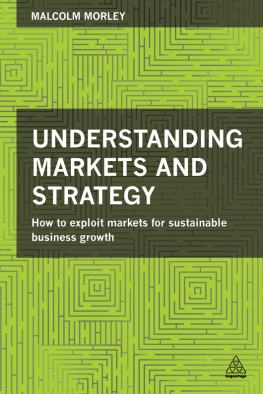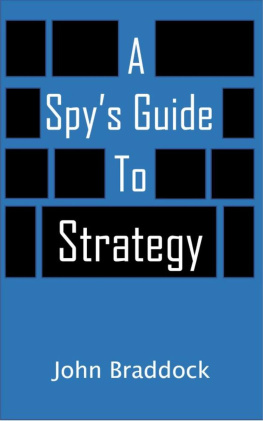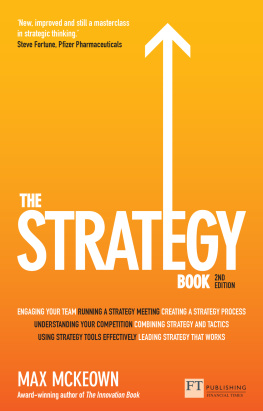
BEYOND
STRATEGY
LEADING YOUR ORGANIZATION
TO REMARKABLE GROWTH
MICHAEL KOULY
Copyright 2018 by Michael Kouly
All rights reserved
No part of this publication may be reproduced, distributed, or transmitted in any form or by any means, including photocopying, recording, or other electronic or mechanical methods, without the prior written permission of the publisher, except in the case of brief quotations embodied in critical reviews and certain other noncommercial uses permitted by copyright law.
First Edition
ISBN 978-0-9992181-7-4
To all those who are striving to make their organizations, countries, and the world a better place
CONTENTS
PREFACE
Writing this book took four years of intense empirical research, which topped some 30 years of practical immersion in the fields of strategy and leadership. The book is also the result of scholarly work with pioneers in strategy and leadership at the Harvard Business School and the Harvard Kennedy School of Government.
The intention of the book is to explore a theory that I have called the Purpose-Driven Growth Model (PDG). I developed the PDG Model after spending years observing (as a CEO, an advisor to boards of directors, and a teacher of executive education) organizations lose opportunities, remain stagnant, and sometimes fail because of strategy and leadership issues.
I saw even the smartest strategies, designed by famous global consulting firms, collapse due to lack of essential leadership. I also witnessed organizational leadership that was stuck in survival mode because it was not guided by intelligent strategies. Without harmonizing strategy and leadership, organizations will continue to struggle. Any model that focuses on one without the other is destined to fail.
This book could not have been completed without significant contributions from a number of good people. I would like to acknowledge my amazing team at our independent boutique think tank the Cambridge Institute for Global Leadership, for their hard work in making this book happen.
I would also like to thank Marwa Itani, who spent three years diligently researching, and then translating the research, ideas, thoughts, and my experiences into the book you see before you. Furthermore, Roy Sayegh, who spent many days helping me refine my thoughts by asking me about the little nuances that define the PDG Model. Roy also was in charge of incorporating the enhancements of every new version.
Mary Shammas beautifully designed the cover and illustrations, and formatted the book. She also gave valuable comments on the content. Dr. Susan Murray and Adam Smith Albion reviewed the book twice, generously offering their insights, and Susan Simons added her usual elegant touches to the artwork of the cover, the illustrations, and the formatting. Karen Tall-entire and Douglas Williams edited and polished early versions of the manuscript, and Jo Lavender deserves much appreciation for later edits of the book, which helped to maximize the reading experience.
I also thank my many friends and loyal readers around the globe for their feedback on the book and its production. Your encouragement keeps motivating my passion for sharing knowledge.
Last but not least, thank you, honorable reader, for choosing this book and for your support of our continued commitment to share with the world everything beautiful weve been taught by life, passionate work, and brilliant people.
Ihope you enjoy the book.
INTRODUCTION

People should not be unfamiliar with strategy, those who understand it will survive, those who do not understand it will perish.
Sun Tzu

I will respect your time and intelligence.
If you are reading this book, you are interested in strategy. You may or may not have read other books about strategy. Your work may or may not be predominantly strategic. I am confident, however, that like me, you have been bombarded by the word strategy over the past few years. Strategy appears in conversations about business, politics, and everyday life. Some people throw in the word to imply deep thinking and intellectual sophistication without necessarily meaning anything in particular.
Strategy is not about being profitable, earning higher market shares, being the best, being the biggest, winning, or increasing sales. These are just aspirations and hopes. Many organizations today concentrate on these things and fail, not because these things are bad, but because they become the sole focus.
By putting strategy in a wider context and redefining success, you can greatly improve your chance of excelling.

A bad strategy is one that doesnt even try to address an important challenge. Instead, it speaks of aspirations, visions of the future, lays out performance goals, or simply lists a bunch of unconnected actions.
Richard P. Rumelt

This book aims not to discuss strategy as a standalone term, but to view it on a broader and more comprehensive level that also emphasizes leadership. I have learned that even the best strategy has little chance of success if it is not driven by intelligent leadership, which can see its way to execution in spite of existing and emerging challenges. Strategy without leadership is doomed, as is leadership without an adaptive strategy. This book should be considered, in some ways, a hybrid of strategy and leadership, because I have learned that both are vital requirements for survival and growth.
Strategy is a process that helps you to achieve what matters most to you and your organization. To be effective, it needs to be part of the larger framework of a growth mindset and a leadership model.
So, what is growth?
Some define growth as increasing market share, profit, customers, or even geographic reach. However, I choose to adopt a wider definition. I define healthy growth as holistic progress that benefits all stakeholders and generates sustainable financial gains.
In its simplest form, this definition applies to all types of organizations, from a bakery shop to a conglomerate, to a nonprofit organization, and even to a country. For instance, the higher the beneficial value of the goods and services the bakery offers, the more customers will come, and the more often they will return; hence, more profit will be earned. Note that when I refer to the customer, I mean anyone the organization aims to serve, not just those who spend money, so this also applies to nonprofit organizations, where the customer is the person they wish to help.
Increasing financial gains and creating value go hand-in-hand, and both are essential to growth. If you provide value that satisfies and helps individuals grow and prosper, you will have laid down the foundation for a sustainable organization. When people frequent a business, so does their money, and the resulting profits help the organization not only sustain itself, but also acquire more knowledge, provide more training, innovate, and grow.

The purpose of the corporation must be redefined as creating shared value, not just profit per se. This will drive the next wave of innovation and productivity growth in the global economy.
Next page
